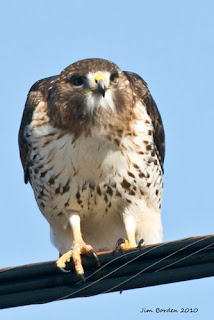We spent Sunday morning and early afternoon at Liberty Marsh in southern New York State observing raptors. We had an eventful morning with two female harriers scooting around but they would not come close enough for good photography. The usual Red Tail Hawk did her routine with sitting on the wire and then diving to catch mice. She seems to like to have her photograph taken.
I experimented with ISO from 500 to 1250 and aperture from 7.1 to 11 to see how I could get the sharpest images of her. I wanted to keep the shutter speed fast enough so that if she decided to fly, I could get crisp flight pictures. I found that with a hawk or eagle I set the exposure comp to at least +.7 when taking pictures against the sky-that insures that the foreground comes out correctly exposed. The coaching I have been receiving is paying off-I have upped my minimum acceptable shutter speed from 1/1000 to 1/1250 and will use ISO up to 1250 on the D300. I use neat image noise ninja to control noise.
I even experimented to manual exposure by exposing for the bird and that way if the bird takes flight an d dips below treeline, the exposure for the bird is still correct and the background can not "fool" the meter.

While we were watching, all of the crows starting taking off and the harriers and red tails took off for the edge of the marsh. We suspected one of the area eagles might be approaching. However, a friend pointed out a peregrine falcon coasting around off in the distance. Once he left, the crows and hawks returned to feeding in the marsh. Early afternoon we took a short trip down the road to visit the long ear owls that have taken residence in an evergreen tree for the winter.

One sits out somewhat in the open and naps along. The other one likes to sit closer to the tree trunk. We used a low powered flashlight to barely light the feathers on this one.

We ended the day by driving to the Shawangunk Grasslands NWR and walked back in to wait for the evening to come. There were three male harriers floating around, but they stayed quite a distance away. Five female harriers started hunting just before dark and then we were rewarded for our wait by the emergence of the short ear owls just before dark. I spotted 16 separate short ear owls. It was a wonderful sight. I tried photographing them in flight, but it was too dark.
I want to thank two mentors for their help through my journey as a "budding" photographer. Thanks Mark Picard and Herb Houghton.
Jim

















